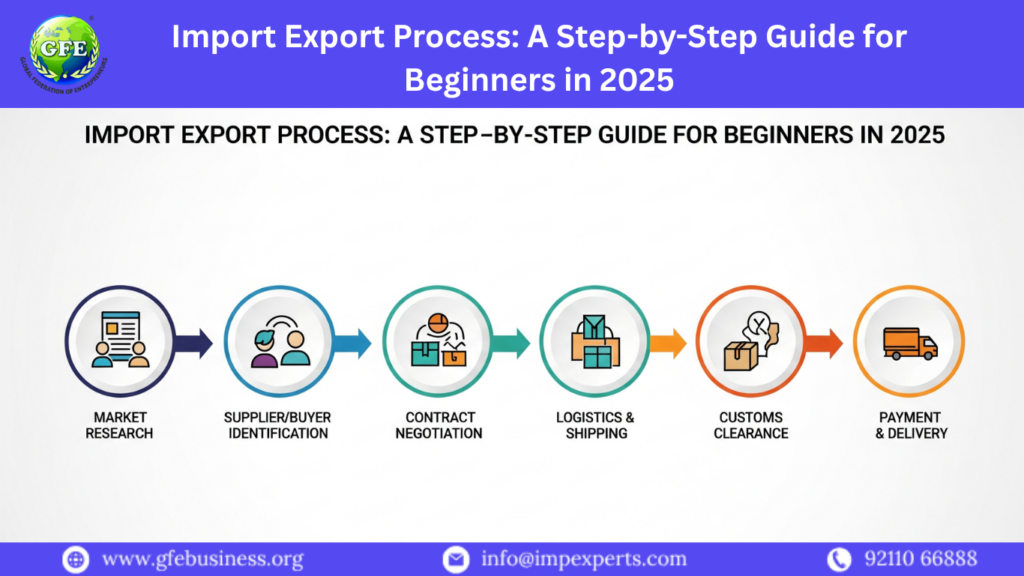India’s growing economy and global trade ties make this the perfect time to explore import-export as a career or business path. But to succeed, you need more than just an idea or a product — you need to understand the import export process from start to finish.
At GFE Business, we specialize in training students, job-seekers, and entrepreneurs to start their international trading journey with complete legal and practical knowledge. If you’re new to this space, this guide will walk you through the full process of starting and managing import-export in 2025 — step by step.
Step 1: Register Your Business
Before trading internationally, you need a legal business identity in India. You can register as:
Proprietorship
Partnership
LLP
Private Limited Company
Choose the structure that fits your scale and future goals. For most beginners, proprietorship is enough to get started quickly and affordably.
Step 2: Apply for an Import Export Code (IEC)
The Import Export Code (IEC) is mandatory for anyone doing international trade from India. You can apply online through the DGFT (Directorate General of Foreign Trade) website.
Requirements:
PAN card
Address proof of business
Bank account in business name
Business registration certificate
IEC is usually issued within 24–48 hours and is valid for a lifetime.
Step 3: Open a Current Account & AD Code Registration
Once your IEC is ready, open a current account with any bank that handles foreign exchange (authorized dealers).
Then register your AD (Authorized Dealer) code with your nearest port/customs office. Without an AD code, your goods will not be cleared for shipping.
Step 4: Choose Your Product
Import export success starts with product research. Your product should meet 3 key criteria:
High demand internationally (for export) or in India (for import)
Competitive pricing
Compliant with Indian and global regulations
Use market research tools like DGFT trade statistics, ITC Trade Map, Amazon Global, or buyer-seller platforms like Alibaba and IndiaMART.
Step 5: Find Buyers or Suppliers
For export, look for:
International buyers through B2B portals
Social media outreach (LinkedIn, Instagram)
Participation in virtual or local trade fairs
For import, find verified suppliers from platforms like:
Alibaba
Made-in-China
Global Sources
1688 (with agent help)
Always start with a sample order or small quantity test batch. Avoid sending full payments without verification.
Step 6: Understand HS Codes and Duty Structure
Every product in trade is classified using an HS Code (Harmonized System Code). This 8-digit code determines:
Customs duties
Documentation requirements
Port clearance conditions
You can find your product’s HS Code on the CBIC portal or by consulting a CHA (Customs House Agent).
Step 7: Prepare the Required Documents
The import export process relies heavily on documentation. Common documents include:
| Document Name | Purpose |
|---|---|
| Commercial Invoice | Pricing and buyer details |
| Packing List | Packaging and quantity |
| Bill of Lading / AWB | Shipment proof (air or sea) |
| Certificate of Origin | Issued by chamber of commerce |
| Insurance Certificate | Proof of goods insurance |
| IEC, GST, AD Code copy | For customs clearance |
Your CHA will use these to file a Bill of Entry (for import) or Shipping Bill (for export).
Step 8: Choose Your Shipping Method
You can transport goods using:
Air Freight – faster, more expensive
Sea Freight – ideal for bulk shipping
Courier – suitable for small items and samples
The terms used in shipping — FOB, CIF, EXW, DDP — define who pays for what. Learn Incoterms before finalizing deals.
Step 9: Clear Customs and Pay Duties
Your CHA will handle customs clearance, calculate duties, and ensure all forms are in place.
For imports:
You must pay Basic Customs Duty + IGST + any additional cess as per product HS Code.
For exports:
In most cases, exports are zero-rated for GST. However, RoDTEP, duty drawback, and other incentives can be claimed later.
Step 10: Receive or Deliver Goods
Once cleared:
Imported goods will be delivered to your warehouse or location
Exported goods will reach the buyer based on agreed Incoterms
You should maintain all post-shipment documents for GST, DGFT audits, or banking purposes.
Step 11: Manage Payments
International trade uses several payment methods:
Advance Payment
Letter of Credit (LC)
Telegraphic Transfer (TT)
Payment through platforms (Google Pay, PayPal, Escrow)
You’ll receive Foreign Inward Remittance Certificate (FIRC) after export payment is received.
Banks may also require a Bank Realization Certificate (BRC) for incentives or proof.
Step 12: Claim Government Benefits (if exporting)
If you’re exporting from India, you may be eligible for:
RoDTEP (Refund of Duties and Taxes on Exported Products)
Duty Drawback Scheme
EPCG License for Machinery
Interest Subsidy Schemes for MSMEs
Apply through DGFT and link your IEC with shipping bills to ensure accurate claims.
Final Words
The import export process is no longer as complex or expensive as it once was. With digital documentation, online IEC registration, and clear compliance rules, anyone — from students to small business owners — can start global trade.
The key is understanding the right steps and following the process without shortcuts. That’s exactly what we train at GFE Business through hands-on classes, real-world case studies, and one-on-one business support.

Visit 








